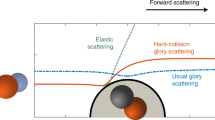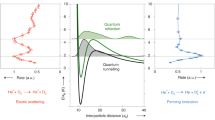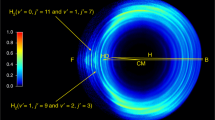Abstract
Over the last 25 years, the formalism known as coupled-cluster (CC) theory has emerged as the method of choice for the ab initio calculation of intermolecular interaction potentials. The implementation known as CCSD(T) is often referred to as the gold standard in quantum chemistry. It gives excellent agreement with experimental observations for a variety of energy-transfer processes in molecular collisions, and it is used to calibrate density functional theory. Here, we present measurements of low-energy collisions between NO radicals and H2 molecules with a resolution that challenges the most sophisticated quantum chemistry calculations at the CCSD(T) level. Using hitherto-unexplored anti-seeding techniques to reduce the collision energy in a crossed-beam inelastic-scattering experiment, a resonance structure near 14 cm−1 is clearly resolved in the state-to-state integral cross-section, and a unique resonance fingerprint is observed in the corresponding differential cross-section. This resonance structure discriminates between two NO–H2 potentials calculated at the CCSD(T) level and pushes the required accuracy beyond the gold standard.
This is a preview of subscription content, access via your institution
Access options
Access Nature and 54 other Nature Portfolio journals
Get Nature+, our best-value online-access subscription
$29.99 / 30 days
cancel any time
Subscribe to this journal
Receive 12 print issues and online access
$259.00 per year
only $21.58 per issue
Buy this article
- Purchase on Springer Link
- Instant access to full article PDF
Prices may be subject to local taxes which are calculated during checkout





Similar content being viewed by others
References
Takatani, T., Hohenstein, E. G., Malagoli, M., Marshall, M. S. & Sherrill, C. D. Basis set consistent revision of the S22 test set of noncovalent interaction energies. J. Chem. Phys. 132, 144104 (2010).
Řezáč, J. & Hobza, P. Describing noncovalent interactions beyond the common approximations: how accurate is the ‘gold standard,’ CCSD(T) at the complete basis set limit? J. Chem. Theory Comput. 9, 2151–2155 (2013).
Tkatchenko, A. & Scheffler, M. Accurate molecular van der Waals interactions from ground-state electron density and free-atom reference data. Phys. Rev. Lett. 102, 073005 (2009).
Grimme, S., Antony, J., Ehrlich, S. & Krieg, H. A consistent and accurate ab initio parametrization of density functional dispersion correction (DFT-D) for the 94 elements H–Pu. J. Chem. Phys. 132, 154104 (2010).
Jankowski, P., McKellar, A. R. W. & Szalewicz, K. Theory untangles the high-resolution infrared spectrum of the ortho-H2-CO van der Waals complex. Science 336, 1147–1150 (2012).
Jankowski, P. et al. A comprehensive experimental and theoretical study of H2–CO spectra. J. Chem. Phys. 138, 084307 (2013).
Shiu, W., Lin, J. J. & Liu, K. Reactive resonance in a polyatomic reaction. Phys. Rev. Lett. 92, 103201 (2004).
Qiu, M. et al. Observation of Feshbach resonances in the F + H2→ HF + H reaction. Science 311, 1440–1443 (2006).
Dong, W. et al. Transition-state spectroscopy of partial wave resonances in the F + HD reaction. Science 327, 1501–1502 (2010).
Henson, A. B., Gersten, S., Shagam, Y., Narevicius, J. & Narevicius, E. Observation of resonances in Penning ionization reactions at sub-kelvin temperatures in merged beams. Science 338, 234–238 (2012).
Wang, T. et al. Dynamical resonances accessible only by reagent vibrational excitation in the F + HD → HF + D reaction. Science 342, 1499–1502 (2013).
Lavert-Ofir, E. et al. Observation of the isotope effect in sub-kelvin reactions. Nature Chem. 6, 332–335 (2014).
Bergeat, A., Onvlee, J., Naulin, C., van der Avoird, A. & Costes, M. Quantum dynamical resonances in low-energy CO (j = 0) + He inelastic collisions. Nat. Chem. 7, 349–353 (2015).
Yang, T. et al. Extremely short-lived reaction resonances in Cl + HD (v = 1) → DCl + H due to chemical bond softening. Science 347, 60–63 (2015).
Klein, A. et al. Directly probing anisotropy in atom–molecule collisions through quantum scattering resonances. Nat. Phys. 13, 35–38 (2017).
Chefdeville, S. et al. Observation of partial wave resonances in low-energy O2−H2 inelastic collisions. Science 341, 1094–1096 (2013).
Vogels, S. N. et al. Imaging resonances in low-energy NO–He inelastic collisions. Science 350, 787–790 (2015).
Chefdeville, S. et al. Appearance of low energy resonance in CO–para-H2 inelastic collisions. Phys. Rev. Lett. 109, 023201 (2012).
Naulin, C. & Costes, M. Experimental search for scattering resonances in near cold molecular collisions. Int. Rev. Phys. Chem. 33, 427–446 (2014).
Chefdeville, S. et al. Experimental and theoretical analysis of low-energy CO + H2 inelastic collisions. Astr. J. Lett. 799, L9 (2015).
Cybulski, H. & Fernández, B. Ab initio ground- and excited-state intermolecular potential energy surfaces for the NO–Ne and NO–Ar van der Waals complexes. J. Phys. Chem. A 116, 7319–7328 (2012).
von Zastrow, A. et al. State-resolved diffraction oscillations imaged for inelastic collisions of NO radicals with He, Ne and Ar. Nat. Chem. 6, 216–221 (2014).
Alexander, M. H. Quantum treatment of rotationally inelastic collisions involving molecules in Π electronic states: new derivation of the coupling potential. Chem. Phys. 92, 337–344 (1985).
de Jongh, T. et al. Imaging diffraction oscillations for low-energy inelastic collisions of NO radicals with He and D2. J. Chem. Phys. 147, 013918 (2017).
Kłos, J., Ma, Q., Alexander, M. H. & Dagdigian, P. J. The interaction of NO(X2Π) with H2: ab-initio potential energy surfaces and bound states. J. Chem. Phys. 146, 114301 (2017).
Acknowledgements
The research leading to these results has received funding from the European Research Council under the European Union’s Seventh Framework Programme (FP7/2007-2013)/ERC grant agreement 335646 MOLBIL. This work is part of the research programme of the Netherlands Organization for Scientific Research (NWO). J.K. acknowledges financial support through US NSF grant no. CHE-1565872 to M.H. Alexander. The authors thank C. Berkhout, N. Janssen and A. van Roij for expert technical support, and Q. Ma for help in fitting the F12 potential.
Author information
Authors and Affiliations
Contributions
The experiments were conceived by S.Y.T.v.d.M. Experiments were carried out by S.N.V. Data analysis and simulations were performed by S.N.V. and J.O. Potential energy surfaces for NO–H2 were calculated by T.K., A.v.d.A., G.C.G. and J.K. Scattering calculations were performed by T.K., J.K., J.O. and M.B. The partial wave analysis was performed by M.B. All authors were involved in interpretation of the data, discussed the results, and commented on the manuscript. The paper was written by S.N.V. and S.Y.T.v.d.M. with contributions from all authors.
Corresponding authors
Ethics declarations
Competing interests
The authors declare no competing interests.
Additional information
Publisher’s note: Springer Nature remains neutral with regard to jurisdictional claims in published maps and institutional affiliations.
Supplementary information
Supplementary Information
Supplementary Methods and analysis, Supplementary Figs. 1–7 and Supplementary Tables 1 and 2
Rights and permissions
About this article
Cite this article
Vogels, S.N., Karman, T., Kłos, J. et al. Scattering resonances in bimolecular collisions between NO radicals and H2 challenge the theoretical gold standard. Nature Chem 10, 435–440 (2018). https://doi.org/10.1038/s41557-018-0001-3
Received:
Accepted:
Published:
Issue Date:
DOI: https://doi.org/10.1038/s41557-018-0001-3
This article is cited by
-
Anisotropic dynamics of resonant scattering between a pair of cold aligned diatoms
Nature Chemistry (2022)
-
Determining the nature of quantum resonances by probing elastic and reactive scattering in cold collisions
Nature Chemistry (2021)
-
Towards chemistry at absolute zero
Nature Reviews Chemistry (2021)
-
Fano interference in quantum resonances from angle-resolved elastic scattering
Nature Communications (2021)
-
Molecular collisions: From near-cold to ultra-cold
Frontiers of Physics (2021)



